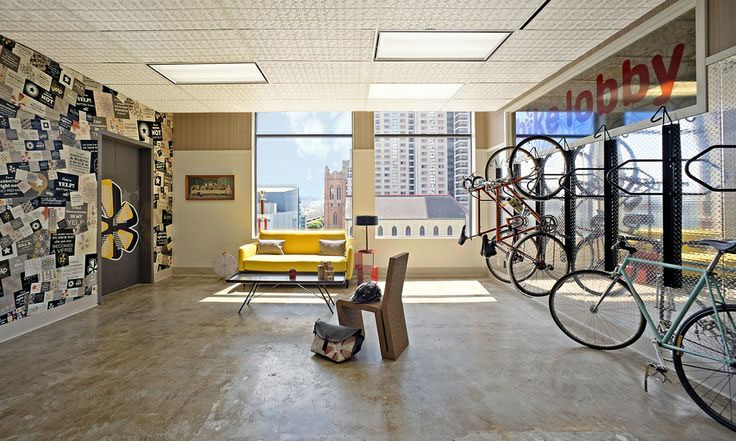Is tech really the demand driver for office space we hoped it would be? Be careful what you wish for.
The experts tell us things are looking up in many of the sectors that have shown flagging absorption of office space in the past five years. But here’s a recap of our current office market situation:
- Law firms — consolidating and shrinking their footprints.
- Federal government office users — shrinking big time.
- Government contractors — emerging from sequestration and federal budget cuts with a more austere approach to their own space utilization.
- Non-profits — right-sizing and greening, due to budget and social pressures.
- Corporate offices — ditto, in many, if not most, sectors.
When you ask everybody where the next wave of office space demand will come from, it seems folks are putting more of their eggs in the tech basket.
Plus: Tomorrow’s workspace: The future is now | Tallest office buildings in the world
The D.C. region, for example, has one of the best ingredients for “thriving” tech companies: a growing population of the most highly educated young people in the country. Moreover, D.C. was recently ranked by NerdWallet.com as the No. 1 most desirable city for recent college grads, and Forbes just rated D.C. the country’s “coolest” city to live in! Sorry, Austin, Miami, Los Angeles, San Francisco and New York. Yes, the conditions are favorable for markets with great quality-of-life attributes to attract tech tenants. But, take note: It’s really the population of Millennial workers as a whole, rather than just the young tech workers, who drive that Q-O-L demand.
Also: What is the current business climate for Millennials? | Don’t dread Generation Y in the workplace
So, is tech really the sector that can ride in on a white horse and stem the losses we have seen in the current market?
Consider this: Many of the big, lumbering bureaucratic government agencies and old-line law firms are throwing big chunks of space back on the market because they are deliberately shrinking their footprint to a fraction of what it used to be.
The tech companies, on the other hand, are showing up “pre-shrunk,” due to their own reduced RSF (Rentable Square Foot)-per-employee requirements. This built-in reduction is mainly the product of recent trends like coworking and hot desking — and increasingly less the product of teleworking and hoteling, as employees and employers have begun to realize how “anti-collaborative” those latter two trends can be. So, it may take proportionately more tech tenants to fill the same amount of space left behind by the traditional space-gobblers.
A number of tech companies that started in garages have grown up to be highly desirable, creditworthy tenants that have recently made major space commitments in markets like New York and San Francisco. But let’s not forget that many of these tech companies are in their infancy. And, as has already been proven in the D.C. market (think member-based web company occupying a historic bank building next to the White House), their space appetite can be as fickle as their balance sheet.
Yelp Headquarters, San Francisco, Studio O+A (O-plus-a.com)
Consider a few pros and cons of leasing to tech tenants:
- Pro: They can grow like a weed – which is good if you have a lot of tenant rollover coming up.
- Con: For the same reason, they are not a good prospect for long-term tenancy if you cannot accommodate that growth.
- Pro: Yes, but that’s a good bet to have a proportionately faster-growing tenant helping to stem building vacancy in a down market.
- Con: True, but the other side of the coin is that they are arguably higher-risk, and, as they grow, your building’s tenant mix becomes less diversified and theoretically more risky.
- Pro: They can make a showplace of your building with their super cool space.
- Con: The next, less cool-minded tenant will want it all torn out.
Now, consider how your building matches up with the tech tenant’s wish list, which are not just your traditional gym, roof deck and concierge-at-the-front-desk amenities.
Tech tenant wishes can include any of the following:
- Lots of natural light
- The most column-free open plan
- The greenest building possible
- The”funnest” building possible, with a lobby that’s not stodgy
- Cost-effective options to run HVAC after hours
- Expansion options
- An “out” if the company needs to shrink or relocate
- Places to get some fresh air
- Numerous transportation options to get there
- Bike racks
- A location where our employees feel safe
- A location where other people in their age group work
- A location that’s walkable to lots of quick, inexpensive places to eat
- A location that’s walkable to the hottest after-work meeting places
- A fun neighborhood where businesses don’t roll up the sidewalks at the end of the work day
So, who is poised to benefit from a possible tech office space “boomlet”? And who will likely lose out?
Winners:
- Buildings close or accessible to where tech employees want to live, work, play, eat and shop and more
- Cool, adaptive reuse projects
- Owners who are more amenable to shorter, more flexible lease terms
- Buildings with floor plates and column spacing conducive to open, naturally lit space
Not winners:
- Buildings with deep cores and limited window line
- Older buildings where the old and the new can’t harmoniously coexist
- Newer buildings otherwise perfectly suited to tech tenants but in locations perceived to be “uncool”
- Buildings with limited telecommunications access and options
The bottom line
We should be glad to have a business sector like tech helping to drive office space absorption in our regions. But let’s remember a few burst bubbles ago, when tech startups were the root cause. Danger, Will Robinson!
Steve is Senior Vice President of Colliers International in Washington, D.C. Having worked for both owners and occupiers, he writes about regional and national business trends. In his spare time, Steve is an accomplished cook and is also putting the finishing touches on his first movie screenplay. Connect with Steve on LinkedIn.

 Colliers Insights Team
Colliers Insights Team


 Ron Zappile
Ron Zappile